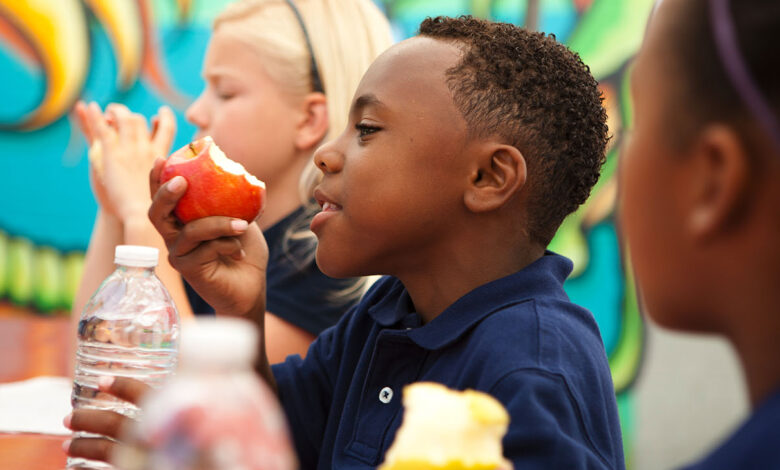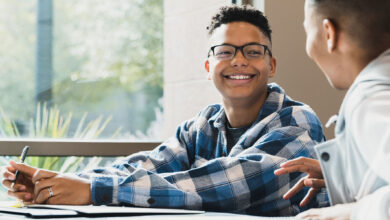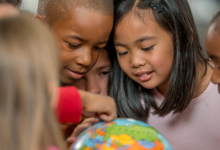
America’s School Lunch Program Is Failing Black Students
By Maya Pottiger | Word In Black | Sacramento Observer
(WIB) – From mushy fish sticks and fries to mystery meat burgers and soggy broccoli, public school lunches in the United States aren’t exactly known as a culinary delight. But these free and reduced-price school lunch meals — as well as a breakfast to start the day — keep millions of low-income students from going hungry. And we’ve known since before the Black Panthers began feeding children in Oakland in 1969 that a disproportionate number of those kids are Black.
So what happens when schools are grappling with the pandemic transition to remote learning, or when individual students are quarantined because they’ve caught COVID-19 — or when their families choose virtual schooling to keep them safe? It turns out that more Black children are going to bed hungry at night.
“What we saw consistently was that families of color, particularly Black families, had food insecurity rates that were two-to-three times as high as white households,” says Elaine Waxman, a senior fellow at the Urban Institute. “That’s not a new story, but again, particularly early in the pandemic, it was really exacerbated for Black families.”
For low-income families, their child’s school can account for two out of three daily meals on weekdays, or a “significant portion” of a family’s food budget, Waxman says. Research has long shown that school meals help reduce food insecurity, which is further proven during summertime when families struggle from not having access to those meals on a daily basis.
“We knew these things coming into the pandemic,” Waxman says. “But the pandemic has really driven home how critical it is.”
How Schools Tried to Alleviate Food Insecurity
Black families reeling from the effects of the pandemic — such as being more likely to be laid off and less likely to be hired, having fewer resources, and high rates of COVID-19 infection and death — found they needed free and reduced-price meals more than ever. But they couldn’t always count on school meals being an option.
Schools tried to shift their mealtime strategies at the beginning of the pandemic, like implementing a grab-and-go option where families could pick up prepackaged meals. But it didn’t work on a large scale, Waxman says, because it’s not practical to leave if you have kids at home — cash strapped parents or guardians would need to hire a babysitter, for example — and you have to weigh the cost of getting there against the value of the food. Plus, schools were facing staffing shortages.
To get more insight, Word In Black used data tables from the Census Bureau’s Household Pulse surveys, which are conducted monthly over a two-week period to collect data on how the COVID-19 pandemic is impacting peoples’ lives.
Questions about free meals and food assistance were not included in the surveys until the end of July 2021. Responses to a survey question about how many children did not receive free meals or food assistance provide a sobering perspective on the problem. In July 2021, only 33% of Black children did not need free meals or food assistance. The most recent data from January 2022 revealed that the situation is slightly better, with only 35% not needing help with food.
“When the rug is pulled, it gets pulled out from everyone, and there’s less of a cushion there for families of color,” Waxman says. Urban Institute’s Fall 2020 coronavirus tracking data showed Black families with kids in school were facing food insecurity at rates of nearly 40%. “That was frightening. And it’s frightening because we know from research that even short spells of food insecurity leave a mark on kids in terms of their health and development,” Waxman says.
The Shortcomings of the Pandemic-Electronic Benefits Transfer
Eventually, the Pandemic Electronic Benefits Transfer (P-EBT) program emerged. Instead of putting the onus on families and schools to coordinate meal pick-ups, the value of missed meals was electronically put on a card for any kid who was eligible for free or reduced-price meals.
The disproportionate negative financial impact of the pandemic on Black communities can be seen in the data. In both July 2021 and January 2022, more Black families by far had received or used an EBT to help buy groceries, according to the Household Pulse surveys. Black families (31%) used EBT cards 182% more than white families (11%) and 287% more than Asian families (8%) in July 2021. The gap closed a bit by January 2022, with Black families (26%) using EBT cards 189% more than Asian and white families (9% each).
However, P-EBT isn’t available to everyone who needs it. The first problem, as the Washington Post reported earlier this month, is that most states haven’t applied to renew the program for the 2021-2022 school year. Currently, only eight states are approved for federal aid, and another 17 are in various stages of the application process.
But even if more states were participating, the U.S. Department of Agriculture (USDA), which runs the National School Lunch Program and P-EBT, has made it so that students who are enrolled in virtual schooling are no longer eligible for free meals. The reasoning is that virtual schools are not equipped with cafeterias or culinary staff, so they would not provide students with meals even in a non-pandemic situation, and there’s nothing “to reimburse families for anyway,” according to The Counter’s in-depth feature on P-EBT.
As Food and Nutrition Service Administrator Cindy Long wrote in a statement to Word In Black: “FNS is committed to ensuring that school meals continue to be a reliable source of nutrition for children throughout the school day. We are acting quickly to leverage flexibilities that have been provided by Congress, recognizing the importance of school meals in protecting our children during this pandemic.”
Urban Institute’s Waxman pointed out that families that enrolled in virtual academies — separate schools that are entirely virtual — chose that option because they were among the most vulnerable.
“I got an email today from a grandparent in a state where that’s what they’ve done because both she and her husband are immunocompromised. They’ve kept the kid home for virtual schooling this year,” Waxman says. “She didn’t realize that that meant there were going to be no benefits. It’s a big problem.”
That reality could be affecting more and more Black families. Though the trend began prior to the pandemic, we’ve also seen a rising number of Black families switch to homeschooling since 2020. Not only do families want to keep their kids safe health-wise, but they’re also fed up with not seeing themselves or their history represented in school textbooks.
Food Insecurity Isn’t New
A September 2021 New York Times story found that food insecurity levels were “unchanged” from where they were pre-pandemic. The story also notes, however, that food insecurity did rise among households with children, Black households, and households in the South.
In the Household Pulse surveys, Black children reported the highest percentage of “often” not having enough to eat. They polled at 4% both prior to the pandemic and in May 2020, the first Household Pulse survey. In January 2022, they polled at 5%. In all three surveys, it was the highest percentage.
“One of the big lessons from the pandemic is the critical role that school meals play as part of the nutrition safety net,” Judith Bartfeld, a researcher at the University of Wisconsin, told the New York Times. “The value of school meals became transparent when the meals disappeared.”
As we’ve seen time and time again, the twin viruses of racism and COVID-19 are taking a toll on Black communities and children.
“It’s really hard because now you don’t even have schools that are in the same status because the school might be in session, but you might have a kid who’s out for 10 days,” Waxman says. “So once again, we’re in the situation where benefits may be coming, but they’re going to come many months after they were first needed.”
“We need a program that can be more easily triggered and can make some really broad assumptions, that say, if we have positivity rates at a certain level, that kids get a benefit,” Waxman says. “I think people worry we should be good stewards of government resources. I’m not arguing that. But the trade-off here is food insecurity or a detailed data process. And to me, that’s not a choice, right? You ameliorate the food insecurity, and you understand that that’s an investment worth making.”
Support for this Sacramento OBSERVER article was provided to Word In Black (WIB) by the Chan Zuckerberg Initiative. WIB is a collaborative of 10 Black-owned media that includes print and digital partners.
The post America’s School Lunch Program Is Failing Black Students appeared first on The Sacramento Observer.










